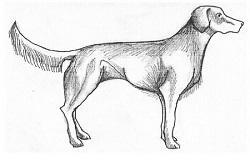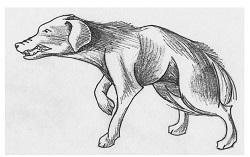
- posted: Jul. 18, 2023
To communicate effectively with your dog, it is important to be aware of and understand his methods of communication.
Dogs use vocalizations (e.g., barks and growls) and body signals (e.g., muscle tension, prolonged eye contact) to communicate with people and animals. To interpret interactions, dogs rely heavily on visual cues (body language/gestures), scent cues (olfactory information), and pheromone detection (processed by the vomeronasal organ). Pheromones are unique chemical signals used to convey messages to specific species.
To communicate effectively with your dog, it is important to learn your dog’s body signals. It is also important to become conscious of your own body language when you interact with your dog, as your dog will naturally infer your intentions based on your postures. Over time, through training, your dog can learn to understand your spoken words as well.
What postures do dogs notice when interacting with people?
Friendly interactions between people are interpreted differently by dogs. People maintain a steady gaze during friendly conversation, whereas dogs maintain a steady gaze or stare to initiate a challenge. When a person stares at a timid dog, the dog might look away to avoid conflict. A bold dog might become aroused and rise to the challenge. An outstretched hand to a person indicates a friendly handshake; to a dog, an outstretched hand represents an unsolicited invasion of space and could generate fear or even aggression.
To get the conversation started, try to notice your dog’s responses to your gestures. Notice details such as the orientation of your dog's body and the direction of its gaze. What is your dog's head and neck position? Are their ears neutral or folded back? Pay close attention to his tail; is it wagging quickly, slowly, or not at all? Is it held high or low? Observe whether the hair on your dog’s back is raised, indicating arousal.
Why do I need to understand dog body language?
Understanding your dog’s body language allows you to respond promptly and appropriately to his communication. With a timely and appropriate response, the dog is assured that his message was received. Misunderstood or unnoticed signals can lead to anxiety or frustration. Frustrated or anxious dogs may use stronger signals to communicate.
For example, a dog may use a subtle posture (looking or leaning away) to communicate that they need more space. If that signal goes unnoticed, particularly when they are afraid, they could use a stronger signal, such as a snap or bite.
Gaining an understanding of dog body language, in any context, will allow you to recognize early signs of fear, anxiety, or frustration. If you frequently notice these signs, discuss your concerns with your veterinarian, who can refer you to a behavior professional.
What does dog body language look like?
Specific movements, body orientation, muscle tension, gaze, and relative position/closeness are ways a dog uses body language to communicate. A dog’s body language may show one signal or a combination of signals at a given moment.
What signs indicate a dog wants to interact?
- Approaching without rushing or hesitating
- Looking toward and facing the person or animal without staring
- Maintaining soft muscles in the face and body
- Holding ears in a neutral position (not pulled far forward or tightly back)
- Holding head in a neutral position (not tucked low or raised high)
- Holding tail in a neutral position (not tucked down or raised high)
- Wagging tail loosely with fluid movement
What signs indicate a dog needs more space or time?
Body postures that communicate a dog’s need for space are sometimes called appeasement body signals. They are used to signal “peace” and serve to prevent physical confrontations during interactions between dogs.
Subtle signs a dog does not want to interact:
- Walking away
- Looking in a different direction, turning head away
- Turning body to the side or away (rather than face-to-face)
- Leaning away
- Sniffing the ground when there is nothing specific to sniff
- Shaking off when not wet
- Yawning when not tired
- Licking lips in the absence of food
- Fidgeting
- Holding up a front paw
- Moving slowly or stiffly
If your dog displays these signals in the presence of an approaching person or animal, protect your dog from the interaction. Move your dog further away or ask the person to refrain from coming closer.
Strong signs a dog does not want to interact:
- Crouching with a low tail and low rear
- Holding tail tucked tightly between the hind legs
- Moving away very slowly or very quickly
- Freezing in place
- Hiding behind a person or object
- Lying down, rolling over, showing the groin or belly
- Folding ears tightly back
- Looking away, squinting, or closing eyes to avoid eye contact
As dogs become more uncomfortable, they may use these stronger, more intense signals to make themselves appear less threatening.
Assertive postures a dog uses to signal they need space:
- Standing in a square stance with weight on toes
- Approaching slowly or with stiff movements and weight forward
- Looking directly at the person or animal with prolonged eye contact
- Shifting weight forward rather than back
 Keeping muscles tense in the neck, back, and face
Keeping muscles tense in the neck, back, and face- Holding the ears forward
- Holding the tail taut, stiffly wagging if at all
- Snarling or growling
- Snapping without making contact
Interpret any of these signs as a “stop” sign. Stop approaching the dog. If another person or animal is approaching your dog, protect your dog from that approach. Dogs showing any or all of these signs are preparing to react and need space and time.
What does it mean when a dog shows conflicting body language?
Dogs often exhibit conflicting signals when they are uncertain how to react. For example, when an unfamiliar person approaches holding a tasty treat, a dog may use signals that indicate a readiness to interact, along with signals that indicate a need for more space. Conflicting signals may include:
- Approaching then retreating, often multiple times
- Leaning with the body pulled back but the head and neck stretched forward
- Turning the head away but keeping the eyes on the person – a position that causes the white part of the eye to become very visible, sometimes called “whale eye”
- Engaging in exaggerated behaviors with a familiar person (e.g., pawing, jumping up, licking)
Contributors: Ellen Lindell, VDM, DACVB; Monique Feyrecilde, BA, LVT, VTS (Behavior); Debra Horwitz, DVM, DACVB & Gary Landsberg, DVM, DACVB, DECAWBM, with Theresa DePorter, DVM, DECAWBM, and Jamie Joswich, DVM.
© Copyright 2023 LifeLearn Inc. Used and/or modified with permission under license.
Office Hours
Closed for lunch 12pm to 1pm. For afterhours call 306-378-2252 for the emergency veterinarian on call.
8:00 am - 5:00 pm
8:00 am - 5:00 pm
8:00 am - 5:00 pm
8:00 am - 5:00 pm
8:00 am - 5:00 pm
Closed
Closed

